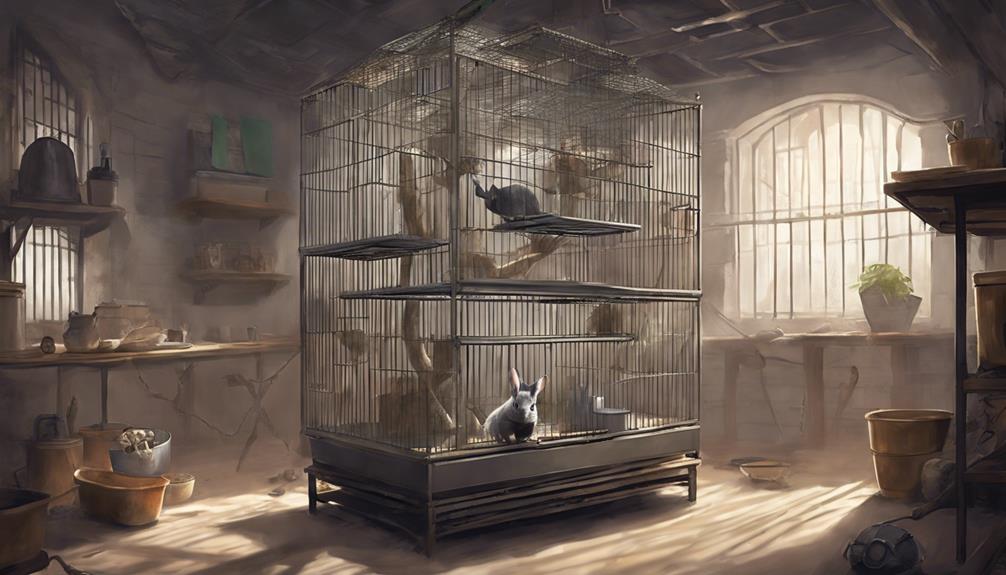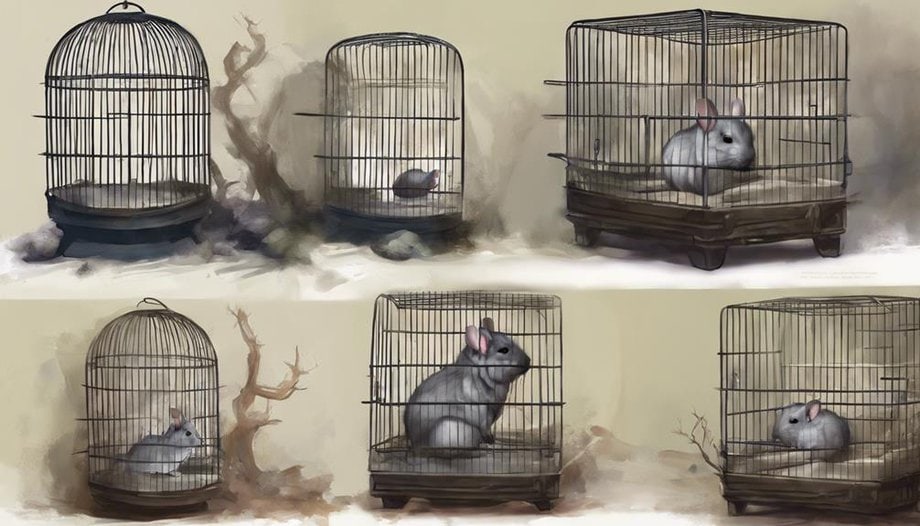How to Choose the Right Cage Size for Your Chinchilla: A Comprehensive Guide

When deciding on the right cage size for your chinchilla, several factors must be taken into consideration. Chinchillas are active animals that require plenty of space to move around and exercise. A cage that is too small can lead to stress and health issues for your pet. The minimum recommended cage size for one chinchilla is 24 inches by 24 inches by 24 inches. However, bigger is always better when it comes to chinchilla cages. Providing a larger cage will allow your chinchilla more room to explore, play, and exhibit natural behaviors. Additionally, chinchillas are social animals and can benefit from having a cage mate, so if you have more than one chinchilla, be sure to choose a cage size that can comfortably accommodate all of them.
Proper cage size is crucial for the health and well-being of your chinchilla. Inadequate space can lead to obesity, muscle atrophy, and behavioral issues. When shopping for a chinchilla cage, look for one that is spacious, secure, and easy to clean. Consider adding platforms, shelves, and toys to provide enrichment and stimulation for your chinchilla. Remember that chinchillas are active and curious animals that need mental and physical stimulation to thrive. By choosing the right cage size and providing a stimulating environment, you can help ensure that your chinchilla lives a happy and healthy life.
Key Takeaways
- Choose a cage size based on the number of chinchillas to allow for exploration and play.
- Provide ample enrichment like toys and platforms to prevent obesity and ensure mental stimulation.
- Understand chinchilla behavior cues for resizing the cage and maintaining mental health.
- Regularly monitor and adjust cage size according to growth and behavioral indicators for optimal well-being.
Importance of Adequate Cage Space
When considering the well-being of your chinchilla, make sure that the cage space provided is ample for their physical and mental health. Chinchillas are lively and curious creatures, necessitating a habitat that fosters their natural behaviors. Cage enrichment plays a crucial role in keeping your chinchilla engaged and happy. Include items such as wooden toys, tunnels, and platforms to encourage exercise and mental stimulation. These additions not only prevent boredom but also promote physical health by allowing for climbing and gnawing, which help maintain healthy teeth.
Additionally, cage ventilation is crucial in ensuring your chinchilla's well-being. Adequate airflow within the enclosure helps regulate temperature and prevents the buildup of ammonia from urine, which can be harmful to your pet's respiratory system. Position the cage in a well-ventilated area, avoiding drafts, to create a comfortable environment for your furry friend. By prioritizing cage enrichment and ventilation, you're providing your chinchilla with a space where they can thrive and express their natural behaviors freely.
Understanding Chinchilla Behavior and Activity Levels
To truly understand chinchilla behavior and activity levels, one must observe their natural tendencies and energy patterns closely. Chinchillas are social creatures that thrive on interaction and play. Understanding their behavior can help in providing them with the appropriate environment for a happy and healthy life.
Here are some key points for consideration:
- Chinchilla Socialization: Chinchillas enjoy the company of their kind and benefit from social interactions. Providing opportunities for socialization can help prevent loneliness and boredom.
- Exercise Options: Chinchillas are active animals that require regular exercise for consideration healthy. Offering exercise options like a wheel or supervised playtime outside the cage can help them burn off excess energy.
- Energy Levels: Chinchillas are most active during the evening and night. Observing their energy levels throughout the day can help in determining the best times for play and exercise.
- Behavioral Cues: Paying attention to your chinchilla's body language and vocalizations can provide insights into their mood and preferences, aiding in creating an enriching environment.
Factors to Consider When Selecting Cage Size
Selecting the appropriate cage size for your chinchilla is important for ensuring their well-being and comfort in their living space. When considering the size of the cage for your furry friend, there are several factors to keep in mind. Chinchillas are active animals that require plenty of space to move around, exercise, and explore. Additionally, providing them with a stimulating environment that includes cage accessories such as platforms, hammocks, and chew toys is essential for their mental and physical health. Multi-level cages are a great option as they offer different levels for your chinchilla to climb and play, mimicking their natural habitat in the wild.
To help you visualize the importance of cage size, consider the following table:
| Factors to Consider | Description |
|---|---|
| Activity Levels | Chinchillas are active animals that require space to exercise. |
| Cage Accessories | Providing platforms and toys is vital for mental stimulation. |
| Multi-Level Cages | Offer different levels for climbing and playing. |
| Space Requirements | Ensure enough room for comfort and movement. |
Recommended Minimum Cage Dimensions
Properly sizing a chinchilla's cage is vital for their well-being.
The ideal cage dimensions provide ample space for activities and create a comfortable living environment.
Ensuring the cage meets recommended minimum dimensions is essential for the overall health and happiness of the chinchilla.
Ideal Cage Sizes
Ensuring the comfort and well-being of your chinchilla begins with providing a cage that meets the recommended minimum dimensions for their best living space. When considering ideal cage sizes, remember that ample room is key to a happy chinchilla.
Here are some recommended minimum dimensions to guide you:
- Single chinchilla: A cage size of at least 3 feet by 2 feet by 2 feet is recommended.
- Pair of chinchillas: For two chinchillas, opt for a cage size of at least 4 feet by 2 feet by 2 feet.
- Cage accessories: Include platforms, hammocks, and chew toys for enrichment.
- Exercise options: Provide a wheel and ample space for your chinchilla to run and play freely.
Space for Activities
To cater to your chinchilla's need for activity and exploration, the recommended minimum cage dimensions must allow ample space for movement and engagement. Chinchillas are active animals that require space for exercise options, both vertical and horizontal, within their enclosure. Providing them with enrichment opportunities such as toys and accessories further enhances their well-being. The table below outlines the minimum dimensions needed to create a stimulating environment for your furry friend. Remember, a spacious cage not only promotes physical health but also supports mental stimulation, leading to a happier chinchilla.
| Activity | Minimum Space Required |
|---|---|
| Horizontal Exercise | 24" x 24" |
| Vertical Exercise | 24" x 36" |
| Toys and Accessories | Varied throughout cage |
| Exploration Area | 6 square feet |
| Resting Space | 12" x 12" |
Comfortable Living Environment
Creating a harmonious living environment for your chinchilla starts with ensuring the cage dimensions meet the recommended minimum requirements for their comfort and well-being. To provide a cozy space for your furry friend, consider the following:
- Space to Move: Chinchillas are active creatures, so a cage with ample room for them to run and play is essential.
- Cage Accessories: Include items like ledges, hammocks, and chew toys to keep your chinchilla entertained and engaged.
- Ventilation: Proper airflow within the cage is vital for your chinchilla's respiratory health.
- Hideouts: Provide cozy hideouts where your chinchilla can retreat when they need some privacy or rest.
Tips for Setting Up the Cage Interior
For a chinchilla's cage interior, meticulous attention to detail is imperative to secure their well-being and comfort. The cage layout plays an essential role in providing enrichment and stimulation for these intelligent creatures. Make sure the cage is spacious enough to accommodate various accessories and toys that encourage physical activity and mental engagement. Chinchillas are naturally curious and active, so a well-thought-out layout will keep them entertained and prevent boredom.
When setting up the cage interior, consider adding platforms or shelves for climbing and jumping, as these activities mimic their natural habitat. Include hiding spots such as tunnels or small houses to create a sense of security. Additionally, provide chew toys made of safe materials to promote dental health and prevent boredom-related behaviors like excessive chewing.
Remember to regularly rotate and introduce new toys to keep your chinchilla mentally stimulated. By creating a dynamic and engaging environment within the cage, you can make sure your furry friend leads a happy and fulfilling life.
Common Mistakes to Avoid in Cage Sizing

When considering the size of a chinchilla's cage, overlooking the importance of adequate space can lead to detrimental consequences for the well-being of the furry companion. Ensuring the cage is appropriately sized is essential for the chinchilla's health and happiness.
Here are common mistakes to avoid in cage sizing:
- Underestimating Necessary Space: Chinchillas are active animals that require ample room to move around.
- Neglecting Vertical Space: Chinchillas love to jump and climb, so vertical space is as important as floor space.
- Ignoring Cage Decoration: A bare cage can lead to boredom and stress. Include items like ledges, tunnels, and chew toys.
- Overlooking Cage Maintenance: A larger cage may seem like more work, but proper maintenance is essential for the chinchilla's well-being.
Monitoring and Adjusting Cage Size Over Time
To verify the well-being of a chinchilla, one must pay close attention to the growth and space requirements that may prompt the need for a larger cage. Behavioral cues, such as increased restlessness or decreased activity, can also signal the necessity to adjust the cage size accordingly.
It's essential for chinchilla owners to monitor their pets regularly and be prepared to make necessary adjustments to the cage size as needed for optimum comfort and health.
Growth and Space Requirements
Ensuring that your chinchilla's living space accommodates its growth and space requirements is vital for their well-being and comfort. To achieve this, here are some essential considerations to keep in mind:
- Regular Growth Monitoring: Keep track of your chinchilla's growth to anticipate when adjustments to the cage size will be needed.
- Space Adjustment: Modify the cage dimensions accordingly to provide ample room for your chinchilla to move around comfortably.
- Cage Dimension Flexibility: Opt for a cage that allows for adjustments or extensions as your chinchilla grows.
- Playtime Integration: Supplement the cage space with regular playtime outside the enclosure to ensure your chinchilla gets enough exercise and mental stimulation.
Behavioral Cues for Resizing
Monitoring your chinchilla's behavior can serve as a valuable indicator for when it may be time to adjust the cage size to accommodate their changing needs.
Behavioral changes, such as increased restlessness, excessive chewing on cage bars, or decreased activity levels, may suggest that your chinchilla requires more space for their well-being.
These cues indicate a need for cage expansion to provide a more stimulating environment that promotes physical and mental health.
By observing and responding to your chinchilla's behaviors, you can make sure that their living space remains conducive to their natural instincts and behaviors.
Frequently Asked Questions
Can Chinchillas Live in Pairs or Groups in the Same Cage, and if So, How Does This Affect the Recommended Cage Size?
Chinchillas can live in pairs or groups, affecting the recommended cage size based on their social nature. Understanding chinchilla behavior and socialization is key to choosing a compatible cage size for their well-being and happiness.
Are There Any Specific Cage Accessories or Enrichment Items That Can Help Make a Smaller Cage Feel More Spacious for a Chinchilla?
Excitedly exploring options for enhancing a chinchilla's habitat, enriching their space with toys and accessories can transform a modest cage into a magnificent mansion. Enrichment toys and space-saving accessories create a dynamic and delightful environment.
How Often Should the Cage Size Be Reevaluated and Potentially Adjusted as a Chinchilla Grows or Ages?
Regular growth monitoring is essential to determine when cage adjustments are needed for a chinchilla. Age considerations and space requirements evolve over time, necessitating periodic reevaluation of the cage size to guarantee the chinchilla's comfort and well-being.
Are There Any Potential Health or Behavioral Issues That Can Arise From a Cage Being Too Small for a Chinchilla?
Insufficient space in a chinchilla's cage can lead to health risks like obesity and stress-related behavioral changes. Inadequate room limits their natural movements and social dynamics, impacting their overall well-being and happiness.
How Can the Layout and Design of a Chinchilla Cage Impact the Overall Well-Being and Happiness of the Chinchilla Living in It?
Proper space utilization and cage layout are essential for a chinchilla's well-being. A well-designed cage encourages natural behavior and promotes chinchilla happiness. Consider factors like play areas, hiding spots, and room to move freely for a content and healthy pet.











